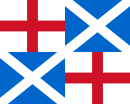English Council of State facts for kids

Flag of the Commonwealth
|
|
| Agency overview | |
|---|---|
| Formed | 14 February 1649 (first time) 25 May 1659 (second time) |
| Preceding agencies |
|
| Dissolved | 30 April 1653 (first time) 28 May 1660 (second time) |
| Superseding agencies |
|
| Type | Advisory body |
| Status | Executive government |
| Headquarters | London, Commonwealth of England |
| Agency executive |
|
The English Council of State was a special group that helped run England after King Charles I was executed in 1649. It was also known as the Protector's Privy Council later on. This council was created by the Rump Parliament to take over the king's job of leading the country.
Before the king's execution, the House of Commons passed a law. This law said that the people's representatives in the House of Commons held all power. It also made it illegal to declare a new king. This effectively ended the monarchy and the House of Lords.
How the Council Started
The Council of State was chosen by Parliament on February 14 and 15, 1649. New members were elected every year. The Council's main job was to act as the government's executive branch. This meant they took the place of the King and the old Privy Council.
Their duties included managing the country's affairs at home and abroad. They also had to make sure the English Commonwealth was safe. Because of disagreements between the New Model Army and Parliament, the Army had a lot of influence over the Council.
The Council held its first meeting on February 17, 1649. Cromwell was in charge of this first meeting. About 14 members attended, which was just enough to meet the minimum number needed. John Bradshaw was chosen as the first president of the Council on March 12. He was famous for being the judge at the trial of King Charles I. He was also the first person to sign the order for the King's execution.
Many important people were part of the first Council. They included Earls, Lords, and other key figures from Parliament and the Army.
Changes and End of the Council
The Council stopped working when Cromwell dissolved the Rump Parliament. This happened on April 20, 1653, with the Army's support. The Council was then reformed on April 29 with 13 members. Seven of these members were Army officers.
Later, when Barebone's Parliament failed, the Council changed again. It became more like the old Privy Council, advising Lord Protector Oliver Cromwell. The new rules said Parliament would elect between 13 and 21 councillors to advise the Protector. However, Cromwell often chose his own councillors, relying on the Army for support.
In 1657, a new set of rules called the Humble Petition and Advice was introduced. This allowed the Lord Protector to choose 21 councillors. It also gave him the power to name his successor. Cromwell chose his oldest son, Richard Cromwell. Richard became the new Lord Protector when his father died on September 3, 1658. Parliament officially confirmed him in January 1659.
After the Rump Parliament was brought back on May 7, 1659, the role of the Council of State became unclear. Many government groups from this time, known as the interregnum, began to fall apart. The Council of State officially ended on May 28, 1660. This was when King Charles II returned to London and took control of the government.
Lord President of the Council of State
The Lord President of the Council of State was the person who led the Council's meetings. They were usually called "Lord President."
John Bradshaw was the first president. He held the position longer than anyone else, serving for almost three years. This was unusual because Parliament passed a rule on November 26, 1651. This rule said that no one could be the chair of any committee or council for more than one month at a time. Even during the time of Oliver and Richard Cromwell, the Lord President position continued. It was known as the Protector's Privy Council until the monarchy was restored in 1660.

